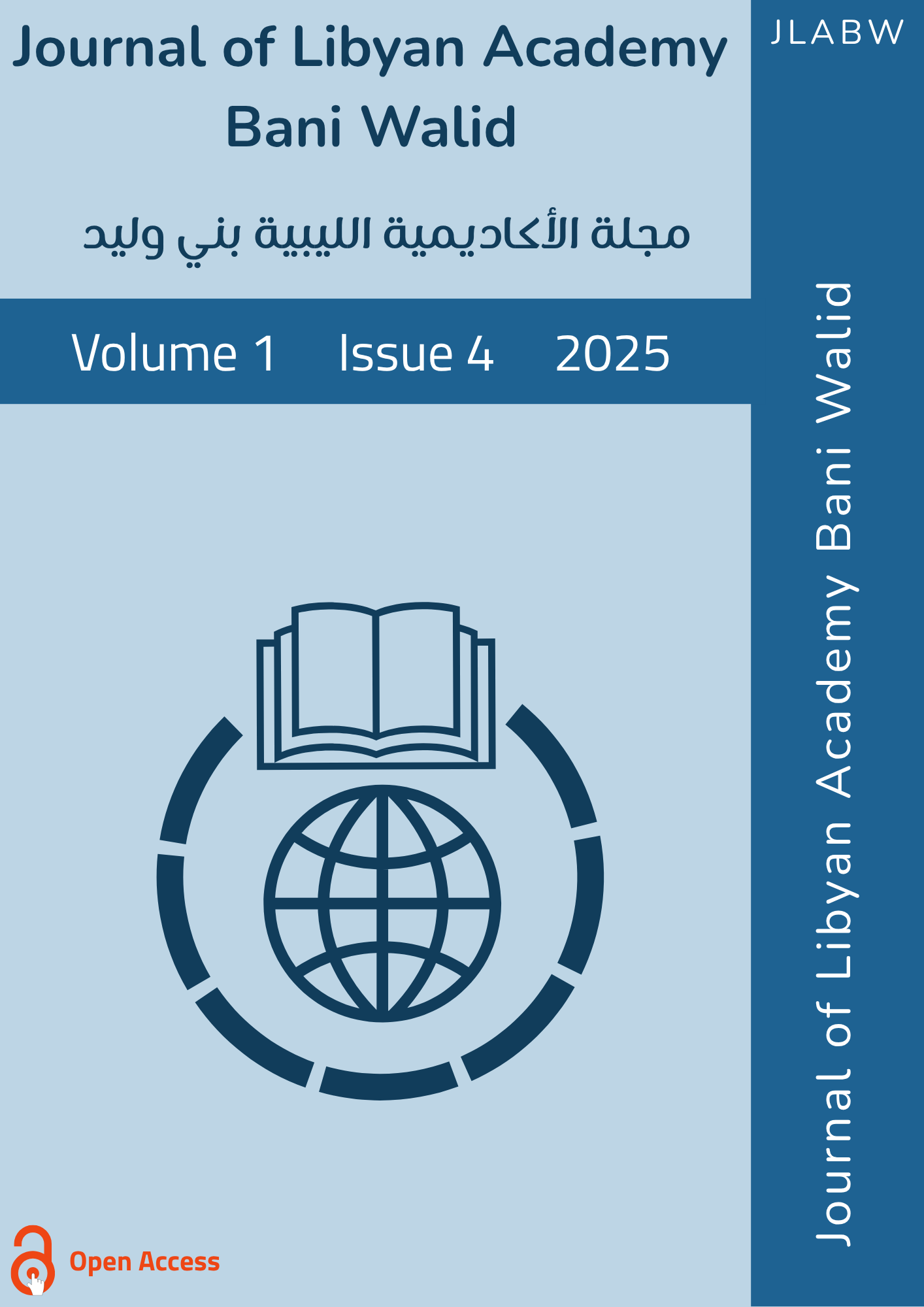Evaluation of the Antibacterial Activity of Natural Honey Against Common Pathogenic Bacteria
Keywords:
Natural honey, antibacterial activity, pathogenic bacteria, Gram-positive, Gram-negative, antibiotic resistanceAbstract
"This study aimed to evaluate the antibacterial activity of natural honey against selected common species of pathogenic bacteria, including both Gram-positive and Gram-negative strains. Eighteen bacterial isolates were obtained from clinical samples collected from Al-Qarawy Ben Nasser Hospital and identified using biochemical tests and the VITEK system. The antibacterial potential of natural honey was assessed using the agar well diffusion method at four different concentrations (25%, 50%, 75%, and 100%)". Results demonstrated that honey exhibited a broad-spectrum antibacterial effect against "Staphylococcus aureus, Streptococcus pneumoniae, Escherichia coli, Klebsiella pneumoniae, and Pseudomonas aeruginosa. The inhibition zones ranged between 3–25 mm, with the strongest inhibition observed at the 100% concentration. Statistical comparison indicated no significant difference between Gram-positive and Gram-negative bacteria in their susceptibility to honey". The study concludes that natural honey possesses significant antibacterial properties that may serve as an alternative or complementary agent to conventional antibiotics, especially in combating antibiotic-resistant bacteria.
References
Amenu, D. (2013). The antibacterial activity of honey. International Journal of Current Research and Academic Review, 2, 102–116.
Brooks, G. F., Carroll, K. C., Butel, J. S., & Morse, S. A. (2007). Jawetz, Melnick and Adelberg’s Medical Microbiology (24th ed.). New York: The McGraw-Hill Companies, Inc.
Carina, L., Soleded, V., & Marina, B. (2014). Antibacterial activity of honey: A review of honey around the world. Journal of Microbiology and Antimicrobials, 6(3), 51–56.
Cooper, R. A., Molan, P. C., & Harding, K. G. (1999). Antibacterial activity of honey against strains of Staphylococcus aureus from infected wounds. Journal of the Royal Society of Medicine, 92(6), 283–285.
Dinkov, D. (2017). Perception of royal jelly and bee honey as new antibacterial therapy agents of hospital infections. Journal of Clinical Pathology and Laboratory Medicine, 1(1), 5–8.
French, V. M., Cooper, R. A., & Molan, P. C. (2005). The antibacterial activity of honey against coagulase-negative staphylococci. Journal of Antimicrobial Chemotherapy, 56(1), 228–231.
Harley, J. P., & Prescott, L. M. (2002). Laboratory Exercises in Microbiology (5th ed.). New York: The McGraw-Hill Companies, Inc.
Hegazi, A. G., Al Guthami, F. M., Al Gethami, A. F., Allah, F. M. A., Saleh, A. A., & Fouad, E. A. (2017). Potential antibacterial activity of some Saudi Arabian honey. Veterinary World, 10(2), 233–239.
Hussain, M. B., Hannan, A., Akhtar, N., Fayaz, Q. G., Imran, M., Saleem, S., & Qureshi, I. A. (2015). Resistant Salmonella typhi. BMC Complementary and Alternative Medicine, 15, 32.
Irish, J., Blair, S., & Carter, D. A. (2011). The antibacterial activity of honey derived from Australian flora. PLoS ONE, 6(3), e18229.
Jawad, M. (2011). Antimicrobial effect of bee honey on some pathogenic bacteria isolated from infected wounds. Journal of Basrah Research (Science), 37(1), 9–12.
Mandal, M. D., & Mandal, S. (2011). Honey: Its medicinal property and antibacterial activity. Asian Pacific Journal of Tropical Biomedicine, 1(2), 153–160.
Molan, P. C. (1992). The antibacterial activity of honey. I. The nature of the antibacterial activity. Bee World, 73(1), 5–28.
Oluwapelumi, O. B., Morayo, A., Buru, A. S., Richard, A. Y., Funmilayo, A. J., & Funmi, A. A. (2017). Antimicrobial activities of different honeys sold in Ado-Ekiti on bacteria associated with upper respiratory tract infections. International Journal of Current Microbiology and Applied Sciences, 6(2), 1–10.
Osho, A., & Bell, O. O. (2010). Antimicrobial effect of honey produced by Apis mellifera on some common human pathogens. Asian Journal of Experimental Biological Sciences, 1, 875–880.
Shenoy, V. P., Balla, M., Shivananda, P. G., & Bairy, I. (2012). Honey as an antimicrobial agent against Pseudomonas aeruginosa isolated from infected wounds. Journal of Global Infectious Diseases, 4(2), 102–106.
Taormina, P. J., Niemira, B. A., & Beuchat, L. R. (2001). Inhibitory activity of honey against foodborne pathogens as influenced by the presence of hydrogen peroxide and level of antioxidant power. Journal of Food Microbiology, 69, 217–225.
Wasihun, A. G., & Kasa, B. G. (2016). Evaluation of antibacterial activity of honey against multidrug-resistant bacteria in Ayder Referral and Teaching Hospital, Northern Ethiopia. SpringerPlus, 5(1), 842.





